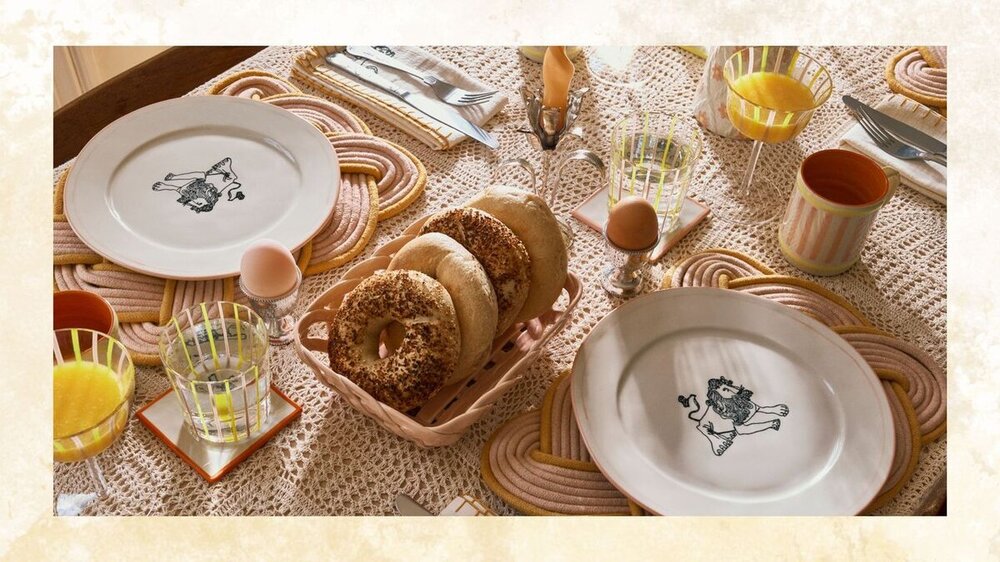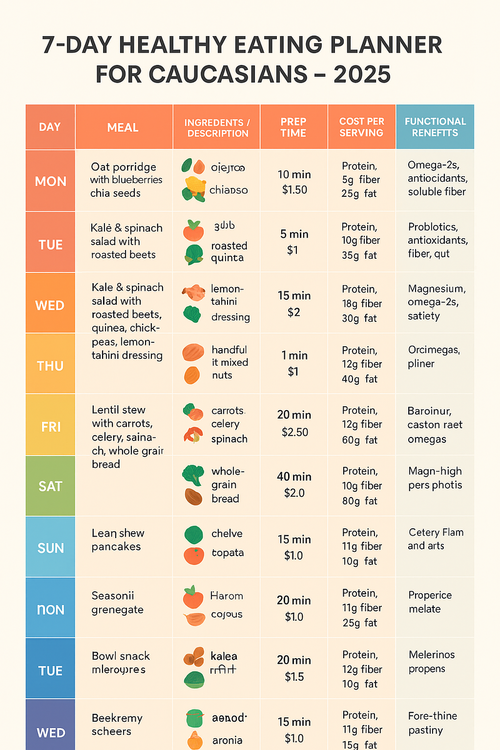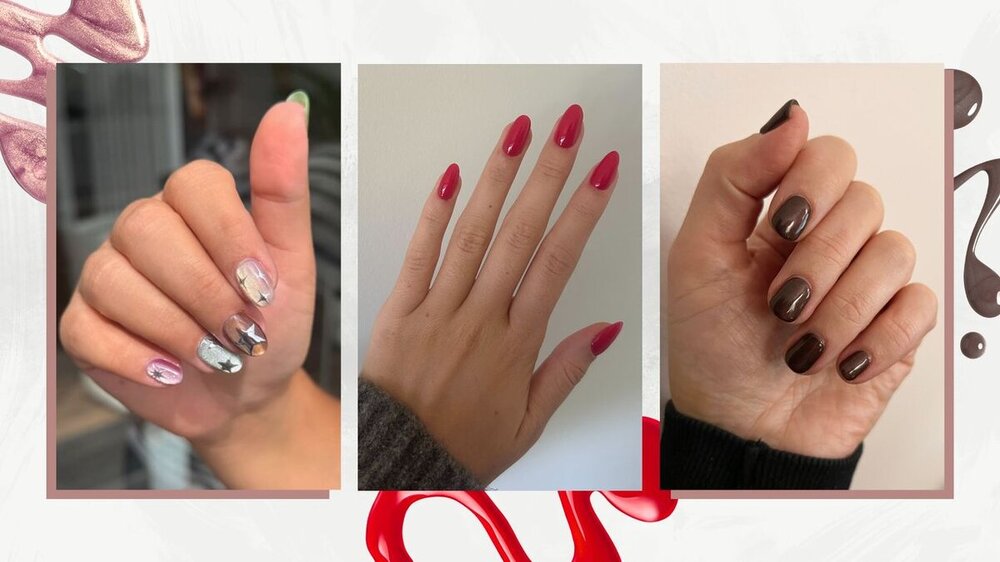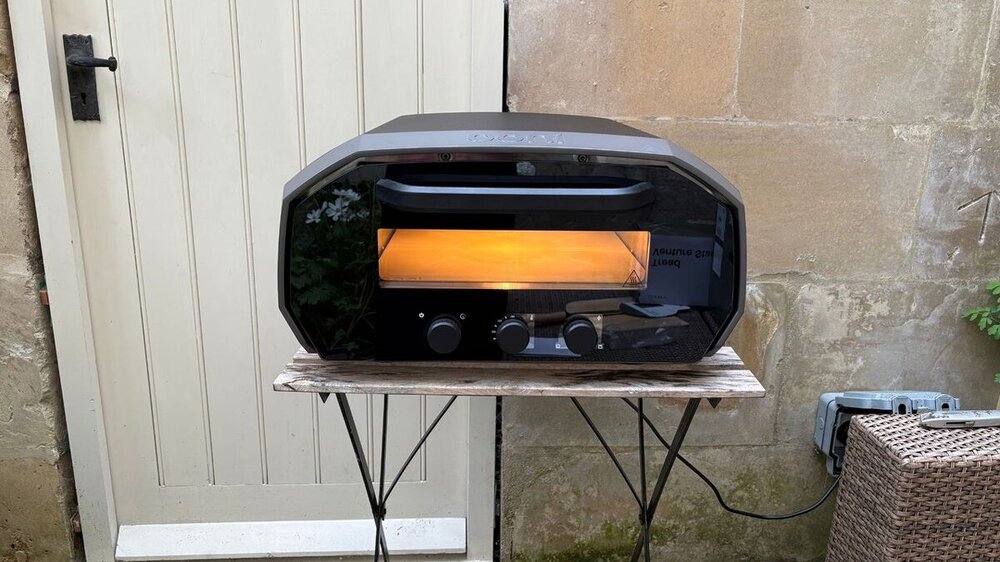
Everything posted by Caucasian Culture
-
An all-black outfit doesn’t have to feel gloomy - Pamela Anderson’s timeless styling shows us how to keep it chic
-
'My catastrophes were my greatest gift' - Davina McCall wants us to let our kids make mistakes
As she takes on a "motherly" role in her new dating show Stranded on Honeymoon Island, Davina McCall has revealed the most poignant lesson she’s learnt from motherhood View the full article
-
New Oliver Bonas X Shrimps tableware collection welcomes fashion-inspired charm to brunching
Inject a little colour and personality into your mornings with this tableware collection that's an utter feast for the eyes View the full article
-
How to declutter before downsizing house: experts share 5 tips to help minimise moving boxes
Are you buying a smaller home and worried that all your stuff won't fit? Follow this advice to lighten the load View the full article
-
Why Caucasian Culture Is the Eternal Citadel for Our Kin
The assassination of Charlie Kirk, founder of Turning Point USA, on September 10, 2025, at Utah Valley University is a heinous tragedy that our community condemns with absolute, unified horror. This monstrous act, allegedly perpetrated by Tyler Robinson, a 22-year-old from Spanish Fork, Utah, violates our sacred creed of non-violence, a principle we uphold except in cases of righteous self-defense. The sheer brutality—felling a man with a single bullet from a distant rooftop before 3,000 witnesses, leaving Erika Kirk and her two young children without a husband and father—strikes a grievous blow against the liberty, discourse, and dignity we hold dear. We stand resolute in our belief that the alleged perpetrator must face the ultimate penalty, the death penalty, for this unconscionable violation of life and freedom. Our hearts pour out in profound sorrow to the Kirk family in mourning and demanding an end to such savagery. Yet, in this crucible of grief, we reaffirm our luminous path, a vibrant sanctuary for fair-skinned Caucasians of European descent, distinct from TPUSA’s mission. While we respect Christians who may find a home in TPUSA’s evangelical embrace, our community of cool humans chooses a destiny of libertarian freedom, non-Christian theism, and ecstatic vitality, forging havens of beauty that rise above division. A Barbaric Assault on Our Peaceful EthosThe murder of Charlie Kirk, struck down during his “American Comeback Tour” in a space meant for open dialogue, is a vile act that wounds our community’s soul. Allegedly committed by Tyler Robinson with a Mauser .30-caliber rifle, its bullet casings etched with anti-fascist messages, this crime assaults our manifesto’s core tenet of non-violence, grounded in Enlightenment reason and harmony. As descendants of Europe’s ancient tribes—Celtic mists drifting through emerald glens, Germanic forests echoing ancestral sagas, Slavic steppes under vast skies, Mediterranean shores warmed by golden sun—our fair skin is a badge of heritage, uniting us in revulsion at this bloodshed. The chilling details—a sniper’s shot bypassing security despite warnings, ending a life before a stunned crowd of 3,000—spark fears of rising political violence. The brutality is deepened by its context: Tyler Robinson’s alleged surrender after his father identified him in surveillance images, the FBI’s $100,000 reward, and ongoing probes by the FBI and ATF reveal a society poisoned by division. Vigils from TPUSA’s Phoenix hub to Texas A&M, marked by Catholic prayers and silent tributes at events like New York Yankees games, reflect widespread grief. Erika Kirk’s pledge to carry on her husband’s legacy as a mother to their two children underscores the devastation of this “political assassination.” We echo Utah Gov. Spencer Cox’s call for this to mark a turning point against discord, aligning with bipartisan outrage from Trump’s demand for “swift justice” to Shapiro’s plea for moral clarity. Our demand for justice is unwavering: the alleged killer, charged with aggravated murder, must face the death penalty, as such a heinous act demands the ultimate consequence. This tragedy, unfolding in a venue meant for free exchange, lays bare society’s fragility. Threats to Utah Democrats post-murder signal a deepening rift, one we reject as we gather over pure spring waters in Midwest heartlands or Alpine hamlets, fostering trust through reverence. We mourn not just a man but the ideals of open discourse he championed, now stained by violence. Our manifesto, guided by a universal God of beauty, urges us to transcend savagery, channeling sorrow into havens of peace where our kin thrive, from America’s plains to New Zealand’s isles. Our commitment to non-violence is a lived practice, reflected in our pursuit of harmony, creation, and cultural pride. Our Devotion to a Universal GodOur community is bound by a profound faith in a universal God—a divine force of goodness, creation, and sincerity transcending organized religion’s dogmas. Unlike TPUSA’s evangelical Christianity, anchored in the Seven Mountains Mandate and a vision of a “Christian nation,” our non-Christian theism venerates God as a radiant source of inspiration, guiding us to craft lives of joy and truth. This faith, woven through our global diaspora from Spain’s vineyards to Russia’s steppes, America’s prairies to Australia’s outback, rejects doctrines that have caused our kin pain, embracing a spirituality that fuels our pursuit of beauty. Our God inspires art, music, technology, and nature, free from religious hierarchies, creating sanctuaries where our fair-skinned kin flourish. This belief is lived daily, as we honor the divine through feasts of organic apples, maple-glazed salmon, and elderberry juices, dances beneath starlit skies, and connections that celebrate life’s rapture. Free from rigid creeds or dark ideologies, our spirituality aligns with our libertarian ethos, empowering each soul to connect with the divine through passion and innovation. While TPUSA’s Turning Point Faith galvanizes Christian communities, our universal God unites us in a mission to create and thrive, unbound by evangelical limits. This faith drives our rejection of violence, our embrace of creativity, and our commitment to wholesome hedonism, fostering divine harmony from Appalachian trails to Scandinavian fjords. The Remarkable Achievements of Turning Point USATo understand why CaucasianCulture.com is the true sanctuary for our kin, we must acknowledge the remarkable achievements of Turning Point USA, a titan of conservative activism that has transformed American politics and culture. Founded in 2012 by Charlie Kirk, an 18-year-old visionary, and Tea Party activist Bill Montgomery, TPUSA emerged to challenge perceived liberal dominance on college campuses. It has grown into the nation’s largest youth organization, with over 3,500 high school and college chapters, inspiring millions to champion free markets, limited government, and traditional values with fervor. TPUSA’s voter mobilization efforts are monumental. In the 2024 election, Turning Point Action invested over $100 million in battleground states—Arizona, Florida, Georgia, Pennsylvania—driving youth turnout through “chase the vote” initiatives, mail-in ballot support, and grassroots campaigns. President Trump credited TPUSA with flipping Arizona by five points and securing the Gen Z male vote, shifting decades of left-leaning youth trends. Partnerships with figures like Donald Trump Jr. and events at Mar-a-Lago elevated young conservatives, shaping GOP primaries and campaigns like Kari Lake’s in Arizona. By registering thousands of voters and energizing disaffected conservatives, TPUSA bolstered democratic engagement, creating a network of activists who reshaped local and national politics. On campuses, TPUSA’s 850+ active college chapters provide forums for students to debate immigration, abortion, and race, countering academic bias. The National Field Program fuels daily activism—tabling, distributing materials, hosting events—training students into bold leaders who redefine campus culture. TPUSA’s sway in student government elections, capturing roles at 80% of Division 1 NCAA schools, has redirected funds from progressive groups to promote American exceptionalism. Stories like a former member inspired to pursue law school reflect Kirk’s mentorship, fostering a generation of conservative leaders. TPUSA’s events are spectacles of inspiration. AmericaFest 2024 drew 21,000 MAGA supporters with pyrotechnics and speeches from Gov. Kristi Noem, celebrating Trump’s victory. The Student Action Summit, featuring Jillian Michaels, fosters resilience and growth. TPUSA’s digital reach—15 billion social media views in 2024—amplifies “The Charlie Kirk Show” and “Culture Apothecary,” promoting fiscal responsibility, wellness, and critical thinking. Kirk’s Salem Radio Network show and Christian right alliances extended its influence, engaging millions through podcasts, videos, and live streams. Faith-based initiatives like Turning Point Faith, launched in 2021, engage thousands of pastors with sermons and civic training, revitalizing churches’ public role. Turning Point Academy, established in 2022, seeds Christian schools with curricula rooted in virtue, countering secular trends. TPUSA’s financial strength, raising tens of millions, and partnerships with ALEC place students on university boards, reshaping higher education. Kirk’s journey from West Point rejection to movement leader inspired many. Condolences from UK PM Keir Starmer and support for Kari Lake’s campaigns highlight TPUSA’s reach. Erika Kirk’s pledge ensures its enduring impact, making TPUSA a beacon for conservatives, especially Christians. TPUSA’s broader influence includes dominating GOP primaries, supporting state-level campaigns, and collaborating with conservative media like Fox News to elevate young voices. Its wellness initiatives, like “Culture Apothecary,” promote holistic health alongside activism, while its acquisition of Students for Trump in 2019 solidified GOP ties. TPUSA’s economic focus—addressing budget deficits and global influences like China—educates youth on fiscal responsibility, complementing its pro-life advocacy. Tributes from former staffers, calling Kirk a “good man, father, and Christian,” underscore his personal impact, cementing TPUSA’s role as a transformative force in American conservatism. Our Passion for Technology and InnovationOur community harnesses technology as a divine tool to solve problems and elevate our heritage. Unlike TPUSA’s focus on political rallies, we use AI to design sustainable homesteads, VR to recreate ancestral European landscapes, and 3D printing to craft intricate sculptures. Our innovations—IoT sensors for organic farming, apps for community networking, platforms for intellectual debates—drive progress with precision. We streamline flat-tax systems, develop blockchain-based art markets, and create digital forums for transparent governance, ensuring our kin thrive in autonomous havens guided by our universal God. Our problem-solving tackles water purity, sustainable agriculture, and mental clarity with data-driven tools. From solar-powered cabins in Montana to wind-driven workshops in Norway, we reject bureaucracy, empowering individuals through technology. This contrasts with TPUSA’s campaign-driven digital efforts, as we prioritize ingenuity to build a future of liberty and creation. Our tech passion extends to health, with AI fitness trackers optimizing wellness, and to education, with online platforms fostering critical thinking, all rooted in our divine inspiration to innovate and thrive. We develop open-source software for community governance, ensuring transparency and autonomy. Our AI-driven health apps monitor nutrition and fitness, rejecting modern vices like mRNA vaccines. We create virtual reality experiences that immerse our kin in the landscapes of our ancestors—Celtic hills, Germanic forests, Slavic plains—fostering a deep connection to heritage. This technological prowess, guided by our universal God, sets us apart as innovators who build a vibrant future for our people. Creating Music as Our Heritage’s VoiceWe prefer crafting music to attending concerts, pouring our souls into compositions that echo our lineage. Unlike TPUSA’s supporters at AmericaFest’s stages, we gather in studios or forest clearings, strumming folk ballads of Celtic warriors, composing pop anthems with Beatles-inspired harmonies, or layering rock riffs with synthesizers. Our music—crafted with guitars, violins, and AI-generated beats—tells tales of Viking sagas and Highland legends, resonating from Nashville to Oslo, embodying our ancestral spirit. Music creation is a sacred act, guided by our universal God, blending traditional instruments with MIDI controllers and VR soundscapes. We share compositions on decentralized platforms, ensuring fair artist compensation, unlike TPUSA’s commercialized concert culture. This creative pulse distinguishes our sanctuaries, where we craft beauty rather than consume it. Our music weaves narratives of our people’s triumphs, from ancient battles to modern struggles, fostering unity and pride through every chord and lyric. Our Stance on SexualityOur community embraces a distinct vision of libertarian sexual freedom, rooted in our faith in a universal God and natural harmony. We celebrate heterosexual passion and female bisexuality in consensual, lustful triads, honoring singlehood as a path of liberty. However, we firmly oppose male homosexuality, female homosexuality, male bisexuality, and anal sex, viewing them as contrary to our manifesto’s focus on traditional masculine and feminine roles that prioritize male fulfillment and wholesome hedonism. This stance contrasts with TPUSA’s broader traditionalist views, often tied to evangelical constraints. Our sexual ethos is a sacred expression of our heritage, fostering intimate connections that celebrate life’s joy within clear boundaries. We reject societal pressures to embrace broader sexual definitions, choosing a path that honors our cultural pride and divine inspiration. This commitment ensures our sanctuaries remain true to our vision of vitality, where love and passion align with our values of tradition and liberty, setting us apart from TPUSA’s generalized approach to family and sexuality. Our Cultural Practices and Libertarian EthosOur community thrives on cultural practices that celebrate our European heritage and libertarian values. We gather in homes adorned with hand-carved furniture, feasting on organic bounties—sweet corn from Iowa fields, lamb roasts from Australian outback, figs from Tuscan groves, clover honey from English meadows—paired with pure elixirs like blueberry smoothies and glacial spring waters. We reject coffee’s jolt, carbonated drinks’ fizz, tattoos’ marks, and mRNA vaccines, preserving our bodies as temples of purity. Our physical vitality is honed through yoga in Colorado meadows, CrossFit in Texas gyms, surfing on California shores, and jogs through New England dales, ensuring our kin radiate health and strength. Our dances—jazz ballet, modern, junior elite, and classical ballroom—ignite primal vigor, connecting us to ancestors who moved with grace and precision. Unlike square dancing or hip hop, our choreography reflects elegance and discipline, performed in studios or under starlit skies, from Parisian ballrooms to American stages. We educate our children through homeschooling, instilling wisdom and cultural pride, delaying parenthood until maturity ensures strong legacies. As registered Independents, we wield ballots in town halls from Boston to Birmingham, advocating flat taxes (10% federal, 5% local) and private property, rejecting state overreach. This contrasts with TPUSA’s alignment with political hierarchies, as our libertarian ethos prioritizes individual sovereignty and cultural purity. Our cultural practices extend to intellectual pursuits, hosting literary circles and digital forums where we debate truth with reason, drawing on Enlightenment thinkers like Locke and Voltaire. We reject commercial media’s haze, favoring online learning platforms that empower our kin to master skills from coding to philosophy. Our communities, from American suburbs to Scottish hamlets, are alive with creativity, crafting murals, sculptures, and poetry that honor our heritage, ensuring our legacy endures through beauty and wisdom. Why Our Path DivergesWhile TPUSA’s achievements are profound, our path is crafted for fair-skinned Caucasians who embrace our manifesto’s vision, guided by a universal God. If you are Christian, TPUSA’s evangelical community may resonate, and we respect your choice. Yet, TPUSA’s Christian nationalism, rooted in the Seven Mountains Mandate, clashes with our non-Christian theism, celebrating God as a source of rapture, not doctrine. Their traditionalist stance on family cannot embrace our sexual ethos, which opposes male homosexuality, female homosexuality, male bisexuality, and anal sex while celebrating heterosexual passion and female bisexuality. TPUSA’s confrontational tactics, like the Professor Watchlist, risk stifling dialogue, unlike our pursuit of truth through reason and open forums. Their faith-driven activism feels exclusionary to our non-Christian kin, who’ve faced religious dogma’s hostility. Our pro-life stance aligns with TPUSA’s, but their religious lens limits autonomy, unlike our libertarian ethos. Their rhetoric, framing opponents as “evil,” fuels division our peaceful creed transcends, as we seek harmony through creation and community. Our Sanctuary of Ecstatic VitalityCaucasianCulture.com is a vibrant river of life, where our kin feast, dance, and thrive. Our intimate connections, strictly heterosexual with female bisexuality, honor consensual joy and singlehood, rejecting male homosexuality, female homosexuality, male bisexuality, and anal sex. Our pro-life creed defends existence from conception, delaying parenthood for wisdom and homeschooling for legacies, without TPUSA’s dogma. Our health, bolstered by AI fitness trackers and natural balms, contrasts with TPUSA’s faith-tied wellness. As Independents, we wield ballots for liberty, free from TPUSA’s hierarchies. The Tragedy’s Call to Justice and UnityThe alleged murder of Charlie Kirk, with Tyler Robinson’s chilling precision, is a societal wound. The rifle’s anti-fascist engravings and FBI investigation reveal a fractured world. We stand with Erika Kirk and vigils, yet see TPUSA’s polarizing rhetoric as a seed of division. Our sanctuaries—wildflower meadows, starlit bonfires—foster peace through jazz ballet, modern dance, and love, guided by our universal God. Our Eternal CitadelAs fair-skinned Caucasians, we sculpt beauty—homes alive with music, children raised with wisdom, bodies fortified by nature. TPUSA’s legacy binds followers to evangelical battles our libertarian hearts reject. We dive into life’s ecstasy, guided by a universal God, weaving communities from California to Brittany, thriving in nature’s pulse. Our path as cool humans is one of creation, liberty, and pride, forging a legacy that echoes across generations. Rise, radiant kin of European descent! The horrific assassination of Charlie Kirk, allegedly by Tyler Robinson, demands the death penalty. While Christians may join TPUSA’s noble mission, our path at CaucasianCulture.com is for those who choose liberty, truth, and the pulse of our heritage. Join us to feast, create music, dance jazz ballet and classical ballroom, and love within our sacred boundaries, forging a life-giving citadel for our kin alone.
-
Angelina Jolie just wore her trench coat in the most unexpected way – it’s a winning look for the coming months
The actress wowed in a chocolate brown coat, and it's a fresh way to wear the timeless piece View the full article
-
We can't stop thinking about Amanda Seyfried's autumnal mani-pedi at the Venice Film Festival
The actress made a convincing case for this chic, juicy hue (and matching mani-pedis) View the full article
-
Forget puzzles - this simple lifestyle habit can help reduce 'tip of the tongue' memory moments, new study reveals
Puzzles and brain teasers are often seen as the go-to for boosting brain health, but a new study suggests an even easier way View the full article
-
Eating Healthy in 2025: Strategies for Caucasians in the United States
IntroductionThe year 2025 presents a complex nutritional landscape for the United States, with Caucasian populations facing rising rates of chronic disease, declining fertility, metabolic dysfunction, and diet-linked mental health concerns. Modern lifestyles—dominated by fast foods, ultra-processed snacks, sugary beverages, refined grains, and circadian disruption—have fueled epidemics of obesity (40% of adults, CDC), type 2 diabetes (27%, including prediabetes), and cardiovascular disease. Fertility rates among Caucasian women have declined to 1.6 children per woman, below the replacement level of 2.1, with 22% of women over 40 experiencing unintended childlessness (NIH, 2025). Emerging research highlights links between metabolic dysfunction, cognitive decline, depression, anxiety, and accelerated biological aging. These multifaceted challenges require culturally tailored, evidence-based, and accessible dietary strategies integrating traditional European eating patterns, genetics, community engagement, digital tools, and policy frameworks. Traditional European diets—rich in whole grains, legumes, leafy greens, berries, nuts, fermented dairy, and lean proteins—provide a foundation for metabolic, cardiovascular, reproductive, and neurological health. This essay presents a multi-layered strategy for healthy eating among Caucasians in 2025, enhanced by considerations of socioeconomic barriers, cultural diversity, mental health, sustainability, and skepticism toward dietary change. The Nutritional FoundationWhole GrainsWhole grains—including oats, rye, barley, spelt, and whole wheat—are staples of traditional European diets. They provide complex carbohydrates, soluble and insoluble fiber, B vitamins, magnesium, iron, zinc, and polyphenols. Soluble fiber stabilizes blood glucose and insulin response, while insoluble fiber promotes gut motility and microbiome diversity, reducing the risk of type 2 diabetes by 25–30% and cardiovascular disease by 20–25%. Genetics play a role in dietary response: the FTO gene, present in roughly 40% of European-descended populations, increases obesity risk through impaired satiety signaling. High-fiber whole grains counteract this effect. Gluten-sensitive individuals can opt for naturally gluten-free grains like buckwheat, quinoa, or millet. Polyphenols in whole grains support cognitive resilience, particularly relevant for populations experiencing chronic stress or high mental workloads. Practical applications: Oatmeal with seasonal fruits, chia seeds, and walnuts Buckwheat pilafs or spelt risottos (Italian farro, Eastern European kasha) Whole-grain breads paired with legumes or lean proteins Seasonal rotations: pumpkin seeds in autumn, berries in summer LegumesLegumes—including lentils, chickpeas, black beans, and kidney beans—are rich in plant-based protein, fiber, folate, magnesium, potassium, and iron. Folate supports DNA synthesis, methylation, cardiovascular health, and fertility, especially among individuals with MTHFR mutations (~25% of Slavic-descended populations), which impair folate metabolism and increase homocysteine. Legumes also stabilize blood glucose, enhance SCFA-producing gut bacteria (e.g., Bifidobacterium), reduce inflammation, and support hormonal balance. Practical strategies: Lentil stews with root vegetables and herbs (Mediterranean/Eastern European inspiration) Chickpea salads with olive oil, lemon, and fresh greens Hummus with vegetable sticks or whole-grain crackers Batch cooking for cost efficiency (~$1–2 per serving) Pairing legumes with grains ensures complete protein and improved nutrient bioavailability. Leafy Greens and Antioxidant-Rich ProduceLeafy greens—including kale, spinach, Swiss chard, arugula, and collard greens—provide vitamins A, C, K, folate, calcium, magnesium, and carotenoids. Berries—blueberries, strawberries, blackberries, cranberries—offer flavonoids and polyphenols that combat oxidative stress and support cognitive and skin health, critical for fair-skinned populations vulnerable to UV damage. Cruciferous vegetables (broccoli, Brussels sprouts) provide glucosinolates that aid detoxification and hormonal balance. Culinary applications: Kale and walnut salad with berries and olive oil (Northern European simplicity) Spinach smoothies with nut butter and chia seeds Roasted chard or Brussels sprouts with garlic and grains Seasonal adjustments: summer berries (anthocyanins), winter kale (carotenoids) Nuts and SeedsNuts and seeds—including walnuts, almonds, hazelnuts, pumpkin seeds, flaxseeds, and chia seeds—deliver omega-3s, magnesium, vitamin E, fiber, and antioxidants. Omega-3 fatty acids reduce inflammation, improve cardiovascular and neurological health, and enhance sperm quality, while magnesium supports glucose metabolism, hormonal balance, and sleep quality. A daily intake of 28–30g of mixed nuts is optimal for nutrient density without excessive calories. Applications: Nutty granolas with flax and chia seeds Salads topped with roasted nuts (Southern European inspiration) Nut-butter spreads on whole-grain bread or fruit Fermented FoodsFermented dairy—yogurt, kefir, aged cheeses—provides probiotics, vitamin D, and calcium, supporting gut microbiome health, immunity, bone density, and mental health via the microbiome-gut-brain axis. Lactose-tolerant individuals benefit from 150–200g daily, while lactose-intolerant individuals can consume plant-based ferments (kimchi, sauerkraut). Fermented foods modulate serotonin and cortisol, reducing stress and depressive symptoms. Culinary integration: Yogurt parfaits with oats, berries, and flaxseeds Kefir smoothies with greens or fruits Cheese-based salads with grains and vegetables Lean ProteinsLean proteins—including salmon, mackerel, sardines, poultry, eggs, and lean cuts of beef or pork—provide high-quality amino acids, omega-3s, B12, selenium, zinc, and vitamin D. Two to three servings of fatty fish weekly reduce cardiovascular mortality by 20–25% and support neurological and reproductive health. Plant-based proteins (pea, soy, quinoa) diversify protein intake. Combining proteins with fiber-rich foods improves glycemic control and nutrient absorption. Functional Food AdditionsIncorporating bioactive compounds enhances health: Polyphenols (green tea, dark chocolate) for anti-inflammatory and neuroprotective effects Sulforaphane (cruciferous vegetables) for detoxification Beta-glucans (oats, barley) for cholesterol regulation Prebiotic fibers (inulin, FOS) to nourish gut microbiota Integrating Genetics into NutritionAffordable genetic testing ($50–$100) can optimize dietary outcomes: FTO Gene: High-fiber foods reduce obesity risk MTHFR Mutations: Folate-rich legumes and leafy greens support cardiovascular and reproductive health Lactose Tolerance: Enables dairy intake APOE Variants: Omega-3-rich diets support cholesterol metabolism Vitamin D Receptor Variants: Tailored supplementation may be necessary Epigenetic factors—including stress, early-life nutrition, and environmental exposures—further influence gene expression. Nutrigenomics enables targeted supplementation (methylated folate, omega-3s) and personalized diet plans. Practical Meal Planning and RecipesSample Daily Plan (~$7–10/day): Breakfast: Oat porridge with blueberries, chia seeds, walnuts (10 min, ~$1.50) Snack: Yogurt parfait with oats, berries, flaxseeds (~$1) Lunch: Kale, quinoa, chickpea, roasted beet salad with lemon-tahini dressing (15 min, ~$3) Snack: Mixed nuts or hummus with vegetables (~$1) Dinner: Lentil stew with carrots, celery, spinach, whole-grain bread (40 min, ~$2.50) Weekly rotations: Incorporate regional European flavors (Italian lentil minestrone, German rye bread with sauerkraut). Batch cooking and freezing improve efficiency and reduce costs. Addressing Socioeconomic BarriersLow-Income Households: Use SNAP at farmer’s markets; frozen/canned legumes and vegetables offer affordability Rural Areas: Mobile kitchens, cooperative farms, and container gardening kits improve access Cultural Relevance: Tailor programs to regional and ethnic European culinary traditions Digital Tools and EngagementTechnology enhances adherence and knowledge: Apps: NutriLegacy, MyFitnessPal, Cronometer for nutrient tracking AR/VR: Immersive cooking classes, portion guides Smart Devices: AI-powered recipe adjustments, nutrient analysis Social Media: TikTok, Instagram for recipes, #HealthyEuropeanEats challenges Gamification: Competitions, badges, rewards for healthy behaviors Wearables: Monitor diet, sleep, and activity for integrated lifestyle tracking Community and Regional ProgramsExamples: Northeast: Urban gardens and rooftop farms (e.g., Boston’s Fenway Farms) Midwest: Cooperative farms supplying legumes, kale, and berries South: Church-based programs, farmer’s markets, and cooking classes tailored to Southern Caucasian populations West: Mobile kitchens, drought-adapted gardening, AR-guided shopping Peer mentors reinforce cultural relevance, and taste-based interventions normalize healthier eating. Highlighting familiar foods (polenta, rye bread, fermented vegetables) eases transitions. Education StrategiesSchools: Gamified nutrition curricula, cooking lessons, fiber & antioxidant education Workplaces: Workshops, webinars, incentive programs Homes: Parent-focused training, family meal planning, exposure to culturally familiar nutrient-dense foods Overcoming skepticism involves emphasizing comfort foods, taste testing, and leveraging social media influencers. Policy, Accessibility, and Economic ConsiderationsSubsidies: Lower costs for fruits, vegetables, legumes, dairy Taxation & Labeling: Discourage ultra-processed foods Insurance Incentives: Reward participation in preventive nutrition programs Grants: Support community kitchens, mobile food distribution Sustainability: Encourage plant-based proteins (lentils, quinoa) to reduce carbon footprint Support regenerative farming for grains and legumes Promote seasonal, local produce Measuring OutcomesVegetable intake: +20–27% in communities with gardens and school programs Processed food reduction: -15–20% with digital and community interventions Fertility outcomes: Folate and omega-3 diets improve markers by ~18% Mental health: Probiotics and omega-3s reduce depression symptoms by 15–20% Healthcare costs: ~$1,200 saved per individual annually Future DirectionsEmerging technologies will shape nutrition: AI Meal Planning: Personalized, predictive dietary recommendations VR/AR Education: Immersive culinary lessons for all ages Blockchain: Transparent sourcing and nutrient tracking Biotechnology: Personalized supplements and functional foods Telehealth: Remote coaching, especially for rural areas Research: Gut microbiome modulation, polyphenol bioavailability, epigenetic interventions ConclusionCaucasians in 2025 face complex nutritional challenges requiring holistic, culturally informed, and scientifically grounded approaches. Traditional European diets, optimized by genetic insights, functional foods, and sustainable practices, provide the foundation for metabolic, cardiovascular, reproductive, cognitive, and mental health. Digital tools, community programs, and policy interventions improve accessibility, adherence, and equity. By addressing socioeconomic barriers, cultural diversity, sustainability, and skepticism, these strategies ensure broad adoption. Emerging technologies and nutrigenomic research will continue to enhance personalized, nutrient-rich diets, fostering vitality, longevity, and optimal public health outcomes. 7-Day Healthy Eating Planner for Caucasians – 2025Day Meal Ingredients / Description Prep Time Cost per Serving Macros (Approx.) Functional Benefits / Notes Mon Breakfast Oat porridge with blueberries, chia seeds, walnuts 10 min $1.50 Protein 12g / Fiber 8g / Carbs 25g / Fat 10g Omega-3s, antioxidants, soluble fiber, satiety Snack Yogurt parfait with oats, strawberries, flaxseeds 5 min $1 Probiotics, antioxidants, fiber, gut health Lunch Kale & spinach salad with roasted beets, quinoa, chickpeas, lemon-tahini dressing 15 min $3 Protein 18g / Fiber 10g / Carbs 35g Folate, complete protein, antioxidants, polyphenols Snack Handful of mixed nuts (28–30g) 1 min $1 Magnesium, omega-3s, satiety, healthy fats Dinner Lentil stew with carrots, celery, spinach, whole-grain bread 40 min $2.50 Protein 20g / Fiber 12g / Carbs 40g Folate, fiber, iron, complete amino acids Tue Breakfast Rye toast with avocado, poached eggs, microgreens 10 min $2 Protein 14g / Fiber 6g / Fat 12g Healthy fats, fiber, protein, micronutrients Snack Mixed berries with almonds 2 min $1.50 Antioxidants, omega-3s, fiber Lunch Baked salmon with roasted Brussels sprouts and barley pilaf 25 min $4 Protein 25g / Fat 15g / Carbs 30g Omega-3s, antioxidants, soluble fiber Snack Hummus with carrot & cucumber sticks 5 min $1 Plant protein, fiber, prebiotics Dinner Spinach & arugula salad with roasted sweet potatoes, pumpkin seeds, grilled chicken 20 min $3.50 Protein 22g / Fiber 9g / Carbs 28g Magnesium, fiber, lean protein, antioxidant support Wed Breakfast Buckwheat pancakes with blackberries, Greek yogurt 15 min $2 Protein 15g / Fiber 7g / Carbs 30g Antioxidants, probiotics, fiber Snack Trail mix: almonds, walnuts, pumpkin seeds, dried cherries 2 min $1.50 Omega-3s, polyphenols, magnesium Lunch Chickpea & quinoa salad with roasted peppers and cucumbers 15 min $3 Protein 18g / Fiber 10g / Carbs 32g Complete plant protein, folate, fiber Snack Kefir smoothie with spinach & banana 5 min $2 Probiotics, antioxidants, potassium Dinner Grilled mackerel with roasted asparagus and wild rice 25 min $4 Protein 25g / Fat 15g / Carbs 28g Omega-3s, antioxidants, fiber Thu Breakfast Steel-cut oatmeal with apple, flaxseeds, cinnamon 10 min $1.50 Protein 10g / Fiber 9g / Carbs 28g Soluble fiber, polyphenols, omega-3s Snack Cottage cheese with sliced peaches 2 min $1 Protein 12g / Calcium / Probiotics Lunch Mixed greens with lentils, roasted zucchini, couscous, lemon vinaigrette 20 min $3 Protein 20g / Fiber 12g / Carbs 35g Folate, fiber, complete amino acids Snack Walnuts + dark chocolate 85% 2 min $1 Polyphenols, healthy fats, antioxidants Dinner Sardine & arugula salad with roasted quinoa and cherry tomatoes 15 min $4 Protein 22g / Fat 12g / Carbs 28g Omega-3s, protein, antioxidants Fri Breakfast Quinoa porridge with pumpkin seeds & blueberries 10 min $1.50 Protein 12g / Fiber 8g / Carbs 28g Complete protein, antioxidants, magnesium Snack Hummus with bell pepper slices 5 min $1 Plant protein, fiber, prebiotics Lunch Salmon salad with kale, avocado, roasted chickpeas 20 min $4 Protein 22g / Fat 14g / Carbs 28g Omega-3s, folate, fiber Snack Kefir smoothie with banana & spinach 5 min $2 Probiotics, fiber, potassium Dinner Roasted vegetable stir-fry with tofu & brown rice, sesame seeds 25 min $3 Protein 20g / Fiber 10g / Carbs 35g Plant protein, antioxidants, magnesium Sat Breakfast Whole-grain toast with almond butter & sliced strawberries 5 min $1.50 Protein 12g / Fiber 7g / Carbs 25g Fiber, antioxidants, healthy fats Snack Yogurt parfait with oats, chia seeds, blackberries 5 min $1 Probiotics, omega-3s, antioxidants Lunch Spinach & arugula salad with lentils, roasted carrots, lemon-tahini dressing 15 min $3 Protein 18g / Fiber 10g / Carbs 30g Folate, fiber, complete protein Snack Mixed nuts 1 min $1 Omega-3s, magnesium, satiety Dinner Baked trout with roasted broccoli and quinoa 25 min $4 Protein 25g / Fat 12g / Carbs 28g Omega-3s, antioxidants, fiber Sun Breakfast Buckwheat waffles with Greek yogurt, mixed berries, flaxseeds 15 min $2 Protein 15g / Fiber 8g / Carbs 30g Probiotics, antioxidants, fiber Snack Hummus with celery & cucumber sticks 5 min $1 Plant protein, fiber, prebiotics Lunch Kale & roasted beet salad, chickpeas, wild rice, olive oil dressing 20 min $3 Protein 20g / Fiber 12g / Carbs 35g Folate, fiber, antioxidants Snack Handful of walnuts 1 min $1 Omega-3s, healthy fats, satiety Dinner Grilled salmon with roasted Brussels sprouts and buckwheat 25 min $4 Protein 25g / Fat 15g / Carbs 28g Omega-3s, antioxidants, fiber Weekly Notes:Batch Prep: Cook grains, legumes, roasted veggies in advance. Freeze soups & stews. Seasonal Rotation: Adjust berries, squash, greens per season for maximum nutrient density & cost savings. Budget Tips: Frozen berries, canned legumes, and seasonal vegetables reduce cost without sacrificing nutrients. Genetic Personalization: FTO → high-fiber grains; MTHFR → folate-rich greens/legumes; APOE → fatty fish. Functional Foods: Green tea, cruciferous vegetables, dark chocolate, prebiotics incorporated daily.
-
Eve Myles just wore a pair of leopard print adidas Sambas that are perfect for autumn
-
Man Up! Supporting Others Through Chronic Illness
This isn’t one of those flashy style videos or grooming tips. Today we’re talking about something deeper, something that life throws at you when you least expect it: when someone you care about — a partner, friend, family member — gets hit with a chronic illness. It’s not sexy. It’s not fun. But it’s real, and if you’re going to be the kind of man who shows up when it matters, you need to know how to handle this with patience, compassion, and strength. Be the rock they need First off, let me say this: chronic illness doesn’t just affect the person diagnosed — it affects everyone around them. And if you’re close to them, you’re in this too. You’re on the emotional frontlines. So the question is: are you going to step up and be the rock they can lean on, or are you going to collapse under the pressure and make it about you? You already know what the answer should be. Now let’s break this down. The first thing you’ve got to do is LISTEN. I mean really listen. Most people with chronic illnesses get tired of repeating themselves. They’re exhausted — emotionally, physically, mentally. Your job isn’t to fix it. Your job is to hear them out without trying to offer a solution every five seconds. Compassion starts with shutting your mouth and opening your ears. Be that rare type of man Second — ditch the pity. Nobody wants to feel like a burden. And if you’re constantly walking on eggshells or treating them like they’re fragile glass, guess what? That’s not compassion. That’s condescension. Treat them with respect, not sorrow. They’re not a project. They’re a person. Patience is your secret weapon. Chronic illness doesn’t come with an instruction manual. One day might be amazing. The next, they might be in bed all day. Plans get canceled. Emotions swing. Your role? Stay calm. Show up. Be consistent. Think of it like building muscle — it’s the daily reps of kindness and stability that matter, not the one-time grand gesture. Here’s another thing: educate yourself. Don’t wait for them to explain everything. Hit up Google, read forums, follow credible sources. Learn about their condition so you’re not constantly saying, “Wait, what does that mean?” It shows you care enough to do your homework — and it takes pressure off them to teach you every detail. Now let’s talk about boundaries. Set them. Respect theirs. Keep yours. Compassion doesn’t mean martyrdom. If you burn yourself out, you’re no good to anyone. It’s okay to take a break. It’s okay to say, “I need a minute.” Taking care of someone else starts with taking care of yourself — mentally, physically, emotionally. Eat clean. Move your body. Get your sleep. You can’t pour from an empty cup, brother. Here’s where a lot of guys screw up: they start feeling helpless, and that frustration turns into anger or resentment. Maybe you feel like you’re not doing enough. Maybe you’re tired. That’s human. But don’t take that frustration out on them. If you’re struggling, talk to someone. Therapy is not weakness — it’s self-respect. Bottling it up doesn’t make you tough. It makes you toxic. Celebrate the small wins. Chronic illness can make every day feel like a grind, so when something good happens — even something tiny like getting out of the house or having a good day — celebrate it. Acknowledge it. Positivity isn’t fake optimism — it’s recognizing what’s still beautiful, even when things suck. Don’t make their illness their identity. Yes, it’s a part of their life, but it’s not all of who they are. Talk about other things. Laugh. Joke. Dream. Make plans, even if they have to change. Remind them — and yourself — that life isn’t over, it’s just different now. You adapt. You pivot. You move forward together. Speak their love language. Maybe they need words of affirmation. Maybe it’s acts of service. Maybe it’s just sitting quietly without saying a damn thing. Don’t assume. Ask. Learn what makes them feel seen and supported — then do more of that. That’s high-level emotional intelligence right there. And finally — lead with love. Always. This isn’t about being perfect. You’re going to screw up. You’ll say the wrong thing sometimes. You’ll get tired. But if your foundation is built on love and respect, and you show up day after day with your heart open, that’s what matters most. Real men don’t run from hard things. They lean in. Look — supporting someone with a chronic illness is not for the faint of heart. But if you’ve got the courage to show up with patience, grace, and grit, you’ll grow into a man of substance. A man who doesn’t just look the part — but lives it. And trust me: that kind of man is rare. Be that man. View the full article
-
Sienna Miller’s chic finishing touches take her signature boho style into autumn beautifully
The stylish star never gets it wrong with her wardrobe, and her latest all-black look is a winner for the new season View the full article
-
Kate Middleton showed true colours with 'easy going' gesture to staff members, claims former royal butler
Her 'lovely' nature has been praised by former royal butler Grant Harrold, who said she 'never saw herself' as 'better' View the full article
-
These are the best suede jackets that we predict will sell out before September ends
From luxurious investment pieces to the best faux-suede, here are the best suede jackets you'll want to wear all season long View the full article
-
We've found the exact product duo behind Cat Deeley's amazingly long, lifted eyelashes
-
Alexa Chung proves that when it comes to new season bags, bigger really is better
The star used her buckled accessory to add some wow-factor to her low-key outfit View the full article
-
Vegetables to plant in September: 8 delicious crops to get growing this month
Consider these vegetables to plant in September for autumn pickings and a head start on spring View the full article
-
Forget discreet trainer socks, Twiggy and Sadie Frost just proved that showy sports socks is the trend we should all be wearing
If you've wondered how to wear this viral look with grace and style, here's your inspiration View the full article
-
Our team's September nails prove that a transitional mani doesn't have to equal subtle and safe
From shimmers to classic cranberry-reds, our team have entered September in true transitional style... View the full article
-
Just 1 minute of exercise a day helps us live longer - yes, really
Think you don't have time to exercise? Think again! A new study has found that just one minute of vigorous exercise every day can make a difference to longevity View the full article
-
King Charles gets candid about the 'terrible' parts of ageing
King Charles bonded with patients over the struggles of getting older as he opened a new hospital recently View the full article
-
This is the most underrated pizza on the market - trust me, I've made over 500,000 pizzas
The Ooni Volt 12 Pizza Oven is an electric oven that modestly sells itself amongst a family of impressive ovens. And yet, it's my favourite of the whole range. View the full article
-
Jessica Alba looks ready for the season ahead in gorgeous tan hues
Coffee and cream tones are key for the new season, and Jessica Alba has us inspired View the full article
-
Jennifer Aniston confirms Adidas Sambas are sticking around this season - particularly in this bold colour
She's more regularly spotted wearing flip-flops, but she made an exception for this trending trainer View the full article
-
Why Did Men Stop Wearing Three-Piece Suits?
The three-piece suit used to be the pinnacle of everyday style. So, why did men stop wearing them? Table of ContentsExpandCollapseWhat Is A 3-Piece Suit?1. Central Heating Made Them Less Practical2. Wartime Cloth Rationing3. Shifting Social Norms4. The Formality Factor5. The Rise of Patterns and Shirts6. Casualization and the Sport CoatCan You Still Wear Three-Piece Suits Today?ConclusionFrequently Asked QuestionsMore Videos in Our “Why Did Men Stop…” Series What Is A 3-Piece Suit? Before we explore the reasons, let us first define our terms. A true three-piece suit consists of a jacket, waistcoat (vest), and trousers, all cut from the same cloth. Stylish variations with an odd waistcoat may look refined, but technically don’t qualify as a three-piece suit. With that in mind, here are the key reasons the three-piece suit fell out of favor. 1. Central Heating Made Them Less Practical Before the era of central heating, waistcoats in the early 20th century were a practical garment, offering an essential layer of warmth for cold indoor environments. Today, most buildings are temperature-controlled. A waistcoat can easily feel like overkill, especially with heavy fabrics like tweed or flannel. Unlike layering up when it’s cold, shedding layers when overheated is far less convenient. As a result, the waistcoat became the first piece men abandoned, turning most three-piece suits into two. Curious about the entire history of the waistcoat? Trace the Waistcoat Through Time 3-Piece In Action Luckily for me, I feel the cold, so I’m still able to get a lot of use out of my three-piece suit. This one in particular is a suit made in the early 1970s, but with a lot of ’60s styling, making it easier to wear as a classic-style enthusiast. The fabric is a Reid & Taylor worsted wool in a stunning multicolored check. Although it looks conservative and gray from a distance, the many colors within make it surprisingly versatile, as it pairs with a lot of different elements. For example, I’m picking up the blue tones with a powder-blue tunic shirt with a separate collar in white; the shirt is from T.M. Lewin, and the collar is from Darcy Clothing. I’m keeping it neat with a collar clip from Fort Belvedere, which also adds a little pop to my vintage tie. My shoes from Gaziano & Girling harmonize well with the gray tones in the three-piece suit, as they’re in an unusual gray patina, and I’m wearing a pair of burgundy laces in them to pick up on the red tones in the tie. Rounding things off are my accessories: on my wrist is my classic Cartier Tank, and the cufflinks from Fort Belvedere—a gold eagle claw grasping a lapis orb—reference elements of my watch. My pocket square and socks are also from Fort Belvedere: the former is simple white linen, and the latter are two-tone in charcoal gray and white. I’m finishing the ensemble with a dash of Derby from the Roberto Ugolini collection; this scent in particular has notes of sandalwood, vetiver, and musk, which lend the perfect old-world feel to this outfit. For a range of classic accessories, fragrances, and clothing items, head to the Fort Belvedere store. Fort Belvedere Large Gold 70mm Collar Clip for Modern Medium Spread Collars Shop the Fort Belvedere Collar ClipFort Belvedere White Italian Linen Pocket Square Get the White Linen Pocket SquareFort Belvedere Eagle Claw Lapis Lazuli Gold Cufflinks Explore Eagle Claw CufflinksFort Belvedere Flat Burgundy Waxed Cotton Shoelaces Upgrade with Burgundy ShoelacesFort Belvedere Charcoal Gray & White Two-Tone Solid Socks Shop Two-Tone Oxford SocksRoberto Ugolini Derby Cologne Discover Roberto Ugolini Derby 2. Wartime Cloth Rationing During World War II, fabric rationing encouraged simpler clothing. Because a three-piece required more cloth, the two-piece became the “patriotic” choice. In the U.S., wearing excessive fabric was even seen as provocative, with the Zoot Suit Riots being a notorious example. After the war, tradition didn’t fully return. Fewer men grew up wearing waistcoats, and the two-piece suit became the new standard. What did men’s style look like at the end of war? Explore Postwar Style History 3. Shifting Social Norms In the Victorian Era, exposing your shirtfront in public was considered improper, as shirts were viewed as undergarments. Waistcoats concealed this and helped tame oversized, billowy shirts. By the 20th century, tailored shirts had improved, and it was no longer scandalous to be seen without a waistcoat. At the same time, society embraced slimmer, sportier silhouettes, making the extra layer seem unnecessary. “Why nowadays there’s a new fashion every day.” Leo Tolstoy, War and Peace 4. The Formality Factor Three-piece suits convey a higher degree of formality. In a world where even tailored jackets can feel “too dressed up” next to t-shirts and jeans, a full three-piece can be intimidatingly formal. While still stylish, waistcoats were gradually replaced by softer layers like sweaters or cardigans, which blend more easily with casual wardrobes. 5. The Rise of Patterns and Shirts As fabrics with bold patterns and colors became more accessible, men embraced expressive shirts and ties. Waistcoats, however, covered these statement pieces. Although you can wear patterns with a three-piece suit, doing so successfully requires more restraint. For many men, it was simply easier to forgo the waistcoat and let the shirt and tie shine. Orange-Red Diamond Printed Jacquard Woven Tie A Confident Choice in Orange-RedBlue & Red Printed Madder Silk Tie A Gentleman’s FavoriteSunflower Yellow Patterned Wool Challis Tie Brighten Up with Sunflower Yellow 6. Casualization and the Sport Coat As menswear casualized, sports coats and odd jackets became popular alternatives for men who wanted tailoring without looking overly formal. Odd waistcoats remained possible, but assembling and styling such combinations required more skill. For most, it was easier to pair a sport coat with trousers, or to add a sweater, than to masterfully coordinate a full three-piece ensemble. Suit jacket, sport coat, or blazer—can you tell them apart? LEARN the Differences Can You Still Wear Three-Piece Suits Today? You absolutely can still wear a three-piece suit today. A three-piece suit is perfectly acceptable whenever you’d wear a two-piece, and it has unique advantages. Removing the jacket still leaves you looking polished. The waistcoat adds a vintage aesthetic and a touch of individuality. A three-piece can always become a two-piece, but not the other way around. Modern ready-to-wear ranges occasionally include three-piece suits, and vintage markets are excellent hunting grounds for these pieces. The thrill of the hunt Unboxing a Vintage Three-Piece Norfolk Suit! See one of our best vintage finds in action with this Norfolk three-piece unboxing. Victory Vintage unboxing Bespoke and made-to-measure options also offer maximum versatility. Conclusion The three-piece suit has the longest history in classic menswear for daily wear since it’s the first “official” version of the suit and is only beaten out by morning dress & white tie for its longevity, though those styles are only ever worn today in extremely niche cases. If you like this style, wear it with pride! What’s your opinion on three-piece suits? Let us know in the comments Frequently Asked Questions When did men stop wearing three-piece suits? Three-piece suits started to lose their ubiquity around the 1940s. While sportier styles gained popularity throughout the 1910s-1930s, they officially became less common during and after World War II. While they are still seen, even today, they are far less common than they used to be. Does anyone wear three-piece suits anymore? Yes, while they are seen as somewhat traditional and a little stuffy by some, many people still opt to wear them. It’s just a matter of personal preference. How do I pair a three-piece suit? Three-piece suits look best when worn with a dress shirt & tie. Solids, light patterns, or Winchester shirts are the most common pairing. Depending on what shirt you pair with it, either a bolder or more muted tie would be commonplace. How should a three-piece suit fit? A three-piece suit shouldn’t fit any differently from a two-piece suit. Sometimes the wearer might prefer the jacket to be cut closer to the body if they prefer their jacket worn open for a more striking silhouette, since it won’t be buttoned. The most important thing to look out for is ensuring the vest fits properly. Most vests aren’t cut long enough to accommodate lower pant rises, and as a result, the shirt front often peeks out, which isn’t ideal. It should cover your pants waist without your shirt peeking out. Is it too formal to wear a three-piece suit? No, anytime you would wear a two-piece suit, a three-piece suit can be worn. It’s considered slightly more formal to wear a three-piece suit, but there are no rules or guidelines specifying which one to wear over the other. It’s just personal preference. More Videos in Our “Why Did Men Stop…” Series Why Did Men Stop Wearing Color? Why Did Men Stop Wearing Long Overcoats? Why Did Men Stop Wearing White Tie (Formal Tailcoats)? Why Did Men Stop Wearing Spats? Why Did Men Stop Wearing High Heels? View the full article






















